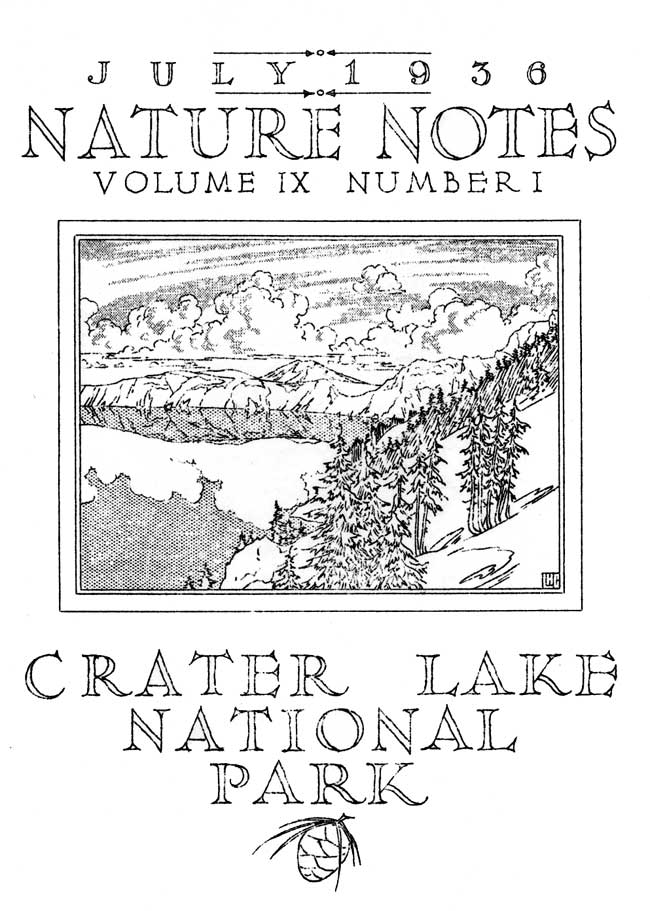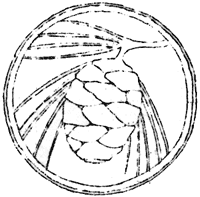
Volume 9 No. 1 – July 1, 1936All material courtesy of the National Park Service.These publications can also be found at http://npshistory.com/Nature Notes is produced by the National Park Service. © 1936. |
Nature Notes from Crater Lake National Park, prepared by the naturalist staff during the summer months, will from time to time include articles on the natural features of Crater Lake National Park as well as on the features of the Lava Beds National Monument and the Oregon Caves National Monument, both of the monuments being under the administration of the superintendent and staff of Crater Lake National Park.
The Lava Beds National Monument, in northeastern California, includes an area of approximately 45,000 acres. As the name suggests, the monument contains outstanding volcanic formations, some of which are of quite recent origin. There are hundreds of subterranean channels or tubes which were once the passageways for streams of molten lava. Numerous symmetrical cinder cones, locally known as “buttes”, rise several hundred feet above the general level of the adjacent country. There are excellent examples of quite recent “aa” and “pahoehoe” lava flows. The Lava Beds National Monument is also interesting from a historical standpoint. The area includes the battlefields of the famous Modoc War of 1872-1873. The area also includes important ethnological and archeological features. Petroglyphs and pictographs on cliffs and in caves are evidence that the region was inhabited by primitive people long before the coming of white man.
The Oregon Caves National Monument is located in the heart of the Siskiyou Mountains in southwestern Oregon. It was established as a national monument in 1909, under the Department of Agriculture. An Executive Order transferred the monument to the jurisdiction of the National Park Service in 1934, the superintendent of Crater Lake National Park being administrative head of the monument.
The caves, named “The Marble Halls of Oregon” by Joaquin Miller, the Poet of the Sierra, are truly marble halls. Underground water penetrating to great depth along fractures in the marble formation has dissolved out an extensive system of chambers. Water, dripping from the ceilings and walls, has decorated the halls and passageways with fantastic stalactites and stalagmites which stimulate ones imagination as well as ones appreciation of the beauties of nature existing in caverns never touched by sunlight.
Clark’s Nutcrackers Banded for Study
By Chas. W. Quaintance, Ranger-Naturalist
Although some eighty species of birds have been recorded in Crater Lake National Park, relatively little is known about how they live. This is the condition of zoology in general; however, in recent years students of zoology have studied animals in their natural state. The results of such studies may be of practical value, and too, they may serve to broaden our mental horizons, and provide a background for our knowledge of animal behavior.
Some of the facts of natural history to be ascertained by studying animals in their natural state may be listed. Mating activities vary, even in related species of animals. It is desirable to know something of the nesting habits, the time of year when the young are born, whether the parents mate for life, and other related information. It is of interest to know what animals eat throughout the year, and whether their food habits have any economic bearing. Other activities and facts to be learned are those concerned with their daily and seasonal movements, including migrations. Information on their voice, mannerisms, and the age that animals normally attain is of value.
One animal chosen for study in Crater Lake National Park is a bird, the most conspicuous one in the rim area, one which is associated in the minds of visitors with the Golden-mantled Ground Squirrels. This bird, Nucifraga columbiana, called variously, Clark’s Nutcracker, Clark’s Crow, Clark’s Jay, and though confused with the Gray Jay, “Camp Robber”, is a member of the crow family. It is named after Captain William Clark, of Lewis and Clark fame, who collected in Idaho the first specimens known to science. The bird is unmistakable in its sharply contrasting coat of gray, black and white.
In this study, observations were made at close range and at a distance, using field glasses. Catching the birds for banding was somewhat of a problem. After experimenting unsuccessfully with government sparrow traps and with figure four traps, it was found that a large hood made of one-inch mesh chicken wire would get the birds fairly easily. Peanuts were used for bait. The chief trouble was that of keeping the Golden-mantled Ground Squirrels away until Nutcrackers got the bait.
Sixteen Nutcrackers were banded, each with an aluminum band of the United States Biological Survey and with three molded celluloid bands. The aluminum band is numbered so that the capture of any bird may ultimately be recorded in the Washington Office of the Biological Survey. The three celluloid bands on each of the sixteen birds were selected from a choice of four colors: pink, blue, yellow and red. With three, colored celluloid bands and one aluminum band to a bird, a large number of banding combinations were possible. The weight of the four bands is estimated to be to the bird what a wrist watch is to a man. These markers do not seem to interfere in any way with the progress of the birds. The fact that they came back to the banding station and the trap indicates that they have no unpleasant association with the experience of being banded. Often after being released (from banding) the birds attempted to peck off the ornaments; however, in a short while they became accustomed to the bands. They will wear the bands for years without any ill effects. The table on page 7 of this issue of Nature Notes gives the banding record of the sixteen Clark’s Nutcrackers and one Oregon Jay banded in Crater Lake National Park during the summer of 1936.
Although the results from a study of this kind are not always immediate, at least one fact is already apparent. At the head of the Lake Trail, the birds which have been banded have been recorded from time to time at this same place, and still more come there which are unbanded. This enables one to say with certainty that although only about four birds appear at a time, a great many different individuals actually visit this place during a day.



